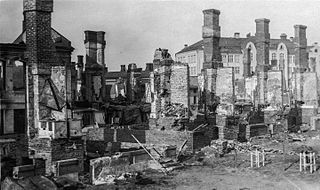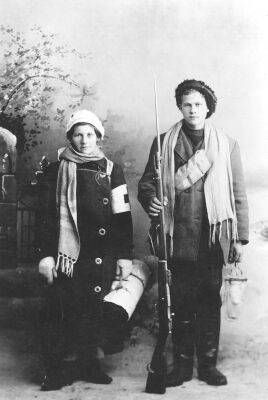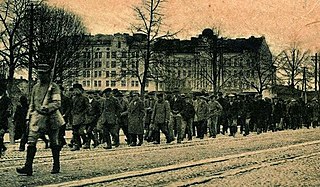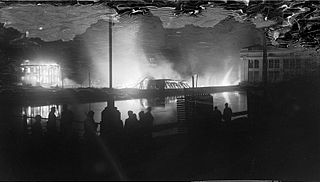
The Finnish Civil War was a civil war in Finland in 1918 fought for the leadership and control of the country between White Finland and the Finnish Socialist Workers' Republic during the country's transition from a grand duchy ruled by the Russian Empire to a fully independent state. The clashes took place in the context of the national, political, and social turmoil caused by World War I in Europe. The war was fought between the Red Guards, led by a section of the Social Democratic Party, and the White Guards, conducted by the senate and those who opposed socialism with assistance late in the war by the German Imperial Army at the request of the Finnish civil government. The paramilitary Red Guards, which were composed of industrial and agrarian workers, controlled the cities and industrial centres of southern Finland. The paramilitary White Guards, which consisted of land owners and those in the middle and upper classes, controlled rural central and northern Finland, and were led by General C. G. E. Mannerheim.

The Red Guards were the paramilitary units of the labour movement in Finland during the early 1900s. The Red Guards formed the army of Red Finland and were one of the main belligerents of the Finnish Civil War in 1918.

The Battle of Tampere was a 1918 Finnish Civil War battle, fought in Tampere, Finland from 15 March to 6 April between the Whites and the Reds. It is the most famous and the heaviest of all the Finnish Civil War battles. Today it is particularly remembered for its bloody aftermath as the Whites executed hundreds of capitulated Reds and took 11,000 prisoners who ended up in the Kalevankangas camp.

Aleksi "Ali" Aaltonen was a Finnish journalist and former lieutenant of the Russian Imperial Army, who served as the first commander-in-chief of the Finnish Red Guards from November 1917 to the end of January 1918. He was executed in Lahti after the Finnish Civil War in May 1918.

Finnish Civil War prison camps were operated by the White Finns to hold prisoners of war during and after the Finnish Civil War in 1918.

The Tammisaari camp was a concentration camp and prison in Dragsvik, Ekenäs in Finland. It was set for the Reds captured by the Whites in the 1918 Finnish Civil War. The concentration camp operated from May 1918 to 15 September 1918 when the majority of the captured Reds were released on parole. Tammisaari camp was then turned into a forced labour camp for convicted Reds and later in the early 1920s into a facility for political prisoners. Tammisaari camp was known as the most notorious of all Finnish Civil War prison camps. Between May and September 1918 nearly 3,000 of the 8,700 prisoners died of executions, disease or malnutrition.
The “Shoot on the Spot” Declaration was a statement issued by Carl Gustaf Emil Mannerheim, military leader of the Whites, on 25 February 1918, in the early stages of the Finnish Civil War. The Declaration was adopted as a rule of engagement of the White troops. Among other things, it directed the troops about the treatment of prisoners, and gave commanders of units wide powers to carry out executions at their sole discretion.

Hans Kalm was an Estonian soldier who served in the armies of Russian Empire, Finland and Estonia. He was also a homeopath and naturopath who took an interest in alternative medicine.

The Battle of Helsinki was a 1918 Finnish Civil War battle, fought on 12–13 April by the German troops and Finnish Whites against the Finnish Reds in Helsinki, Finland. Together with the battles of Tampere and Vyborg, it was one of the three major urban battles of the Finnish Civil War. The Germans invaded Helsinki despite the opposition of Finnish White Army leader Carl Gustaf Emil Mannerheim who wanted to attack the capital city with his own troops after Tampere had fallen on 6 April. However, the Germans had their own interest in taking Helsinki as quickly as possible and then moving further east towards the Russian border. The city had been under Red control for 11 weeks since the beginning of the war.

The Battle of Viipuri was a 1918 Finnish Civil War battle, fought 24–29 April between the Finnish Whites and the Finnish Reds in Viipuri. Together with the Battle of Tampere and Battle of Helsinki, it was one of the three major urban battles of the Finnish Civil War. The battle is also remembered because of its bloody aftermath, as the Whites executed up to 400 non-aligned military personnel and civilians of Russian and associated ethnicities.

Battle of Syrjäntaka was a 1918 Finnish Civil War battle fought on 28–29 April in Syrjäntaka, Tuulos, between the German Baltic Sea Division and the Finnish Red Guards. Thousands of Red refugees were fleeing east, while they were blocked by a small unit of Germans at a highway crossing in the small village of Syrjäntaka. After hours of desperate fighting, the Reds managed to break through and continue their journey. The Battle of Syrjäntaka and the preceding battle in Hauho were the only battles the Germans lost during their one-month military campaign in Finland. They were also the last Red victories of the 1918 civil war. The battle itself was totally unnecessary. It had no effect on the result of the war and neither side gained anything as the fleeing Reds were captured only a couple of days later.

Battle of Varkaus was a battle of the 1918 Finnish Civil War, fought 19–21 February between the Finnish Whites and the Finnish Reds in Varkaus, Leppävirta. The victory was important for the Whites, giving them control of all of Northern Finland. The battle is best known for the bloody Lottery of Huruslahti held afterwards, where the Whites executed up to 180 Reds who had surrendered.

Battle of Lahti was a 1918 Finnish Civil War battle, fought from 19 April to 1 May by the German troops and Finnish Whites against the Finnish Reds in Lahti, Finland. Together with the Battle of Viipuri, from 24 to 29 April, it was the last major battle of the war.

Hennala is a district in the city of Lahti, Finland. It is known of the Stora Enso packaging factory and the former Hennala Garrison which also worked as a concentration camp after the 1918 Finnish Civil War.

All-female units of the paramilitary Red Guards served in the 1918 Finnish Civil War. The first Women's Guards units formed in early February in the main Finnish cities. More than 15 female Guards units were established by the end of March 1918, with a total of about 2,000 women serving. The female Guards units consisted of young industrial workers, maids, and servants. Their average age was about 20, but some were as young as 14. The women served in auxiliary units in combat.

The Battle of Länkipohja was a Finnish Civil War battle fought in the village of Länkipohja on 16 March 1918 between the Finnish Whites and the Finnish Reds. Together with the battles fought in Kuru, Ruovesi and Vilppula between 15 and 18 March, the Battle of Länkipohja was one of the first military operations related to the Battle of Tampere, which was the decisive battle of the Finnish Civil War. The battle is known for its bloody aftermath as the Whites executed 70–100 capitulated Reds. One of the executions was photographed and the images have become one of the best known pictures of the Finnish Civil War.

The following events occurred in April 1918:

Riihimäki prison camp was a prison camp operating in the area of the Riihimäki garrison after the Finnish Civil War in 1918. It held, at most, around 8 500 red guards. According to the war victims of Finland -database, a total of 981 prisoners died in camp, in result of executions, hunger and disease. The camp was closed down in October 1918, and the forced labour facility replacing it was shut down in the spring of 1921. The memorial of the prison camp is located in the Tienhaara part of Riihimäki.
The Harmoinen sick room mass murder was a significant incident in the Harmoinen village of the Kuhmoinen Parish that took place on 10 March 1918, during the Finnish Civil War, which according to the Reds met the criteria for a massacre. It took place during the Battle of Kuhmoinen, when the Whites executed 11 Red Guard patients and two male sanitaries. The Whites belonged to the 1st company and its battalion commanded by the Estonian born Hans Kalm. Kalm was not part of the incident and did not know anything about it, as he was engaged in the defense of the Kuhmoinen parish center at the time, against the Red Guards offensive in the direction of Jämsä. These claims are based on the stories by two survivors, reports by the Whites and other materials. Researcher of political history Jaakko Paavolainen thinks that "it is possible that shots were fired from the sick room, as the Whites have reported, but the claim that the snipers would have retired to the beds inside, is a rather fantastic one."

Suomenlinna prison camp was a 1918 Civil War of Finland concentration camp in the Suomenlinna Fortress, Helsinki. It was established by the White Army for the Red Guard fighters taken prisoner after the Battle of Helsinki. The camp operated from April 1918 to March 1919. It was a subcamp for the Helsinki prison camp, which included the camps of Suomenlinna, Santahamina, Katajanokka and Isosaari.


















